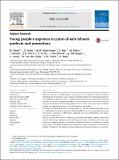Young people's exposure to point-of-sale tobacco products and promotions
Abstract
Objectives. Point of sale (POS) displays are one of the most important forms of tobacco marketing still permitted in many countries. Reliable methods for measuring exposure to such displays are needed in order to assess their potential impact, particularly on smoking attitudes and uptake among young people. In this study we use a novel method for evaluating POS exposure based on young people's use of retail outlets and recall of tobacco displays and observational data on the characteristics of displays. Study design. Observational audit of retail outlets (n = 96) and school-based pupil survey (n = 1482) in four Scottish communities reflecting different levels of social deprivation and urbanisation, conducted in 2013 before legislation to remove POS displays was implemented in supermarkets. Methods. Measures were taken of: visibility and placement of tobacco displays; internal and external advertising; display unit size, branding and design; visibility of pack warnings; proximity of tobacco products to products of potential interest to children and young people; pupils' self-reported frequency of visiting retail outlets; and pupils' recall of tobacco displays. Variation in POS exposure across social and demographic groups was assessed. Results. Displays were highly visible within outlets and, in over half the stores, from the public footway outside. Tobacco products were displayed in close proximity to products of interest to children (e.g. confectionery, in 70% of stores). Eighty percent of pupils recalled seeing tobacco displays, with those from deprived areas more likely to recall displays in small shops. When confectioners, tobacconists and newsagents (CTNs) and grocery/convenience stores (two of the outlet types most often visited by young people) were examined separately, average tobacco display unit sizes were significantly larger in those outlets in more deprived areas. Conclusions. POS displays remain a key vector in most countries for advertising tobacco products, and it is important to develop robust measures of exposure. The data reported in this paper provide a baseline measure for evaluating the efficacy of legislation prohibiting such displays.
Citation
Stead , M , Eadie , D , MacKintosh , A M , Best , C , Miller , M , Haseen , F , Pearce , J R , Tisch , C , Macdonald , L , MacGregor , A , Amos , A , van der Sluijs , W , Frank , J W & Haw , S 2016 , ' Young people's exposure to point-of-sale tobacco products and promotions ' , Public Health , vol. 136 , pp. 48-56 . https://doi.org/10.1016/j.puhe.2016.03.032
Publication
Public Health
Status
Peer reviewed
ISSN
0033-3506Type
Journal article
Description
The study was funded by the UK National Institute for Health Research (NIHR, PHR 10/3000/07).Collections
Items in the St Andrews Research Repository are protected by copyright, with all rights reserved, unless otherwise indicated.

